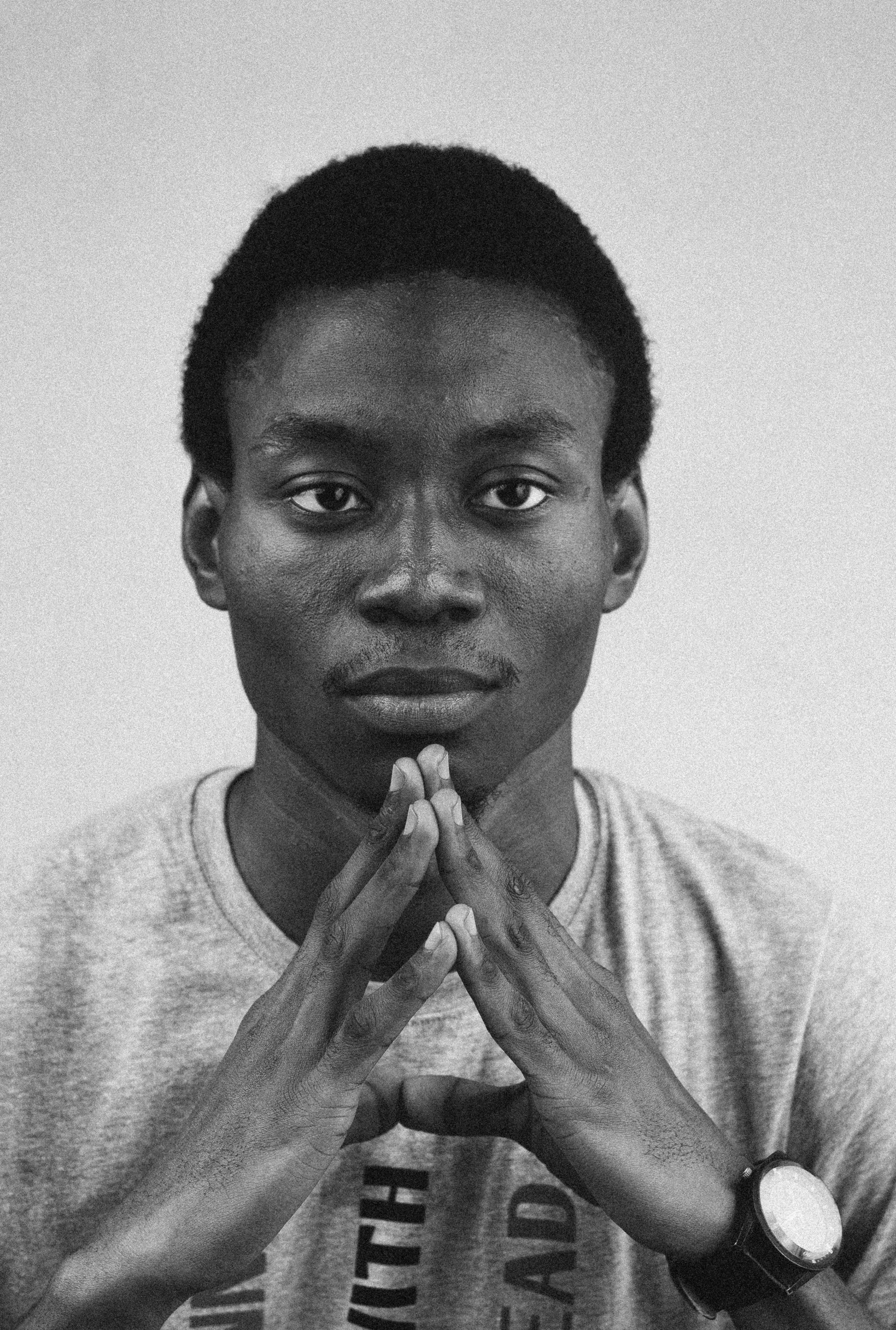There is an image of home I have—one of several—that’s a dark bunk bed, a room suffused in greenish-blue light, a fan rolling away on the ceiling, and a plastic casing of Nas’ album, with Illmatic written in gothic sans. The sounds I remember, tunes born out of this image, are not Nas’—they are Don William’s, singing he’s got silver in the stars; they are 2Shotz and Big Lo’s, calling back and forth to each other. This image of home is a particularly vivid and recurring one, but it is never complete (more accurately, it is never full) without its sounds, slips of music, fragments of lyrics. It reminds me of Geoff Dyer in But Beautiful, describing the best photographs as having their own sounds, as objects to be listened to as well as looked at.
This association between image and music very well works in the reverse: music and sound as things to be looked at, as conjurers of images. The concept was rendered with beautiful directness in Spike Jonze’s 2013 film Her: A man, Theodore Townbly (Joaquin Phoenix) and Samantha (Scarlett Johansson), his AI virtual assistant, fall in love, and in one scene, Samantha proposes to make a photograph of the two of them. Now, without a body (Samantha has none), a photograph of both of them could seem, if not impossible, then absurd. However, Samantha doesn’t see this impossibility or absurdity. She remarks that both of them do not have a photograph together, then she plays a tune and says, ‘… this song could be like a photo that captures us in this moment.’ That scene is utterly believable, utterly true. Music can be a photograph of moments.
A photograph preserves within a frame a time already past, a moment already gone. And it preserves that moment for as long as it continues to exist or be reproduced. Insofar as they perform this function, they can be described as an archive of lost things. Music too can perform a similar function and so earns for itself this description. But unlike photographs delineated by a time frame (the duration of exposure), music is under no such time constraints. It is not sealed off by time the way a photograph is. Music steps with breadth and robustness beyond the time in which it is being recorded. The duration of a piece of music is more or less a door that opens to rooms and corridors, which can stretch far into the past and future, drawing into its brief length diverse moods and moments. The photographs (images) that music makes, it follows from this, are not quite framed up in time nor are they fixed on film. They are diffused over larger spans of time, and they are different for each listener. Each piece of music is many albums of photographs for many different people.
Because these albums of photographs are particular, they become personal. But to what extent can the personal become possession?
I recall one early evening in a keke maruwa at Alagbado, Lagos. Clouds were gathering. A cold wind was blowing, but I didn’t fear any rain. There was music playing in the keke, soft, lusty sounds. The keke driver was singing along.
‘Ta lo n korin?” I asked.
Surprised that I didn’t know who was singing, he turned to look at me. ‘O o mo eni to n korin ni?’
‘Mi o mo,’ I answered, a little embarrassed, and then he told me: ‘Obey ni. Obey l’on korin.’
I nodded, impressed, and the driver continued singing, this time swinging his head, thoroughly enjoying the music. I was enjoying the music too, but it did something else to me. It made me feel nostalgia for a lost time. How does a person feel nostalgic for a time he never experienced, for a world that was never his? This world I yearned for was the world of the 70’s and 80’s, the world of my parents and grandparents. How much possession of that world and experience had such a brief but personal time with that song granted me?
These questions hinted at a kind of restlessness, a searching. But for what? Home? I cannot say for sure. Perhaps a brief resting place. When I think of home, that is as much as I hope for. I carry about fragments of places in which I briefly found rest. I sometimes hide away in images, moods, recollections and sounds that for a time quell the searching, but these are never enough. Soon there comes again the searching. Home is a thing always out of reach.
Three days, four days after, several weeks after, maybe, I began to download Ebenezer Obey’s songs off the Internet and listen to them. I enjoyed them. I loved them, fragmented as my understanding of the lyrics were. I would walk home listening to them. They made walking easier. In the sounds, I found a resting place. But each listening, on some level, stubbornly carried forth the question: can I make a valid claim on the world thrumming in this music, is it possible that world is just as much mine as it is my parents’?
Ebenezer’s “Ibadan” would play sometimes, and I, singing along and high on excitement, would tell my friends who were serving as corps members1 with me that I was really an Ibadan man, from an earlier time. They would indulge me and playfully say I had lived before and in that former life I was a man from Ibadan. But sometimes they pointedly dismissed my jokes and said I was not from Ibadan. My words were meant to be playful and light-hearted, meant to evoke laughter and jauntiness, but on some level, I wished they were true. I listen to Ebenezer Obey, and I grow wistful, feel an aching nostalgia. I feel like a man at a door looking out at a place in which he once roamed free, but now can only miss.
–
The images of home are many and disparate, their sources rooted in diverse geographies. A woman dispensing receipts at the money counter at a bakery in Benin, her elbow hovering over Plato’s Republic on the countertop (a book I know is hers and suspect she is reading seriously. I tell these things from her eyes, wary yet friendly). An evening in Oyo with a family by an outdoor kitchen, the glow of fire, the domesticity of cooking, the welcome antics of children in their own compound. A mother in Lagos with her children at the roadside, children dressed for school and holding their food cases; the mother sweaty and impatient for a keke, the children antsy. And these images have their sounds too, ordinary sounds sometimes—the clack of heels on a tiled floor, the pounding of pestles, the squabble of children by a fence, the hoot and din of traffic—and silence sometimes, which has its own sound. And sometimes yet again, the sound is music. In these instances, the images do not arise from the music so much as rest on them. The music becomes a kind of backing on which these images are imprinted or a kind of air in which they float. Ebenezer’s “Ara n Bada” is a song on which is imprinted many mornings in Ibadan. It is also, to a lesser or larger extent, the air of those mornings. Such music, as I have said, makes their images complete, full. But they do more than this: they strengthen their images, lend them a kind of permanence in the mind.
When I think of a certain friend, I see him more distinctly through his music. Franz Liszt (the Transcendental Études) is whom I hear, mostly. But there are other classical compositions I hear: Bach, Mozart, Chopin, Vivaldi. The music reinforces the image each time: a young man sitting in a corner of a dimly lit room, listening to his music, his hands resting in his laps, head tilted upward in complete entrancement. Tiwa Savage and Burna Boy form a musical atmosphere for the streets of that time from which the image of my friend comes. Those streets take on their detail and vigor from that atmosphere. There are streets we walk built of music, built within music, in which there are friends, moments, neighbourhoods, musical streets in which stand the architecture of memory. These images will endure because, like the music in which they exist, they are renewed on each listening.
My twin brother sent me a voice note on WhatsApp a few months before my writing this essay. In it he was singing. It was a Nigerian Pentecostal song. “You be God, you no be man o…” I laughed hard, because he sang it mimicking my grandmother, creating a funny impression of the mood of our family’s morning prayers several years ago. As I listened to his comical singing, I knew I had made another frame, of a time fading from memory, a time that had already begun to lose its defining details, but had now, through his singing, become rescued. The image in this frame made me grieve as much as it made me laugh. An image may remain, but a time is forever gone. In this way, images become talismans of mourning, because they preserve moments that will never be had again. The moments may or may not have been of significance at the time we lived through them. But they become cherished and missed because they were personal and because an image of them invokes several other moments we cherished.
These images of which I speak are not made from light or held on film—they are not photographs—and so, like memory they are alive and fluid, like music they possess a certain vibration. These words are used deliberately to hint—obliquely—at a kind of disturbance, a kind of time lag. Sometimes the music is absent from its images, sometimes both of them vanish altogether, reminds me of a night when after seeing lightning through my room window and hearing the rumble of thunder moments later, I asked of the lightning: Where did you leave your thunder? And how long ago? There are moments when geography throws up difficult questions.
I have had days, same as everyone, when the images and their music recede, and one does not heed the call of the other. Sometimes the darkness is so long and the silence reigns heavy over everything. You step through doors that are just as dark, hoping to find that room of images in which geography, for the briefest of moments, may disappear and you may come close enough to touch all the things that are yours yet unclaimable. You hope to find that room in which the thunder answers its light.
I know there are many images of home borne about by people, vast libraries inside of them over which they would have taken darkness, the sounds of them so depressing, so disturbing they would gladly exchange them for silence. For them, the doors that look out to home are ones so tough to face they’d rather not. One knows, however, that the libraries of our minds are so vast they afford us doors we can at least stand at to enjoy the solace of nostalgia. One can only hope that these doors are not so hard to find.
Home, wrote Naguib Mahfouz, is where all your attempts to escape cease. I am still searching for such a place. The images of home I bear around and their music come close, but they are never enough; there is always a falling short. They are like doors at which I stand looking out, unable to step through. And so there’s always about them a certain mood of mourning. Still I hold on to them with an attitude almost like a prayer. I draw consolation from them, joy at other times. I find in them what rest I can.


